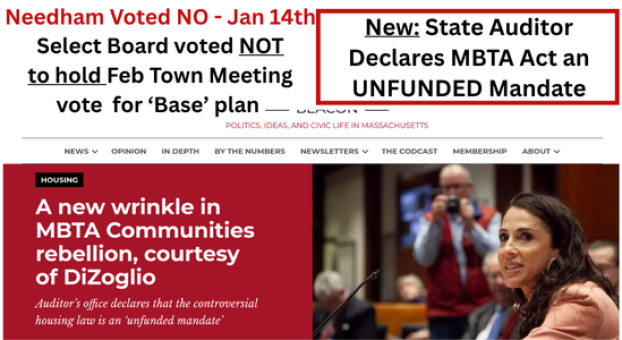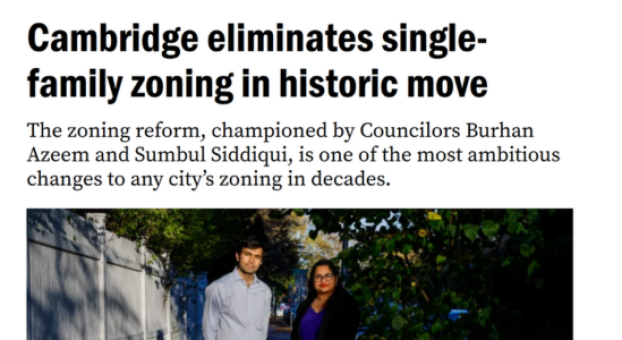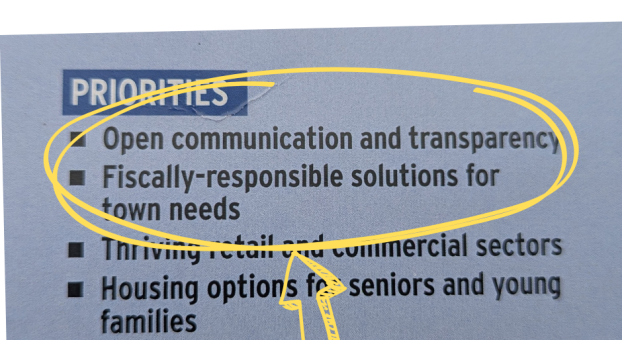Thank You.
To every candidate who stepped up, put their lives on hold, and ran for local office to represent their Needham neighbors – we offer our deepest thanks. Your courage and commitment to public service is truly commendable. We congratulate all the winning candidates on their well-run campaigns and victories. We look forward to working together as a town to make Needham the best town it can be.
To the 6,900+ citizens who came out in January to vote “no”, your voices made history. Thank you. While turnout was high in our recent election, nearly 4,600 less voters took to the polls on April 8 than on January 14, highlighting a challenge we must all face: staying engaged beyond one moment.
With the election in the rear-view mirror, we remain committed to fulfilling our promises:
- To keep residents informed;
- To bring transparency to local decisions; and
- To ensure our elected leaders listen to and thoughtfully consider viewpoints from all residents.
We will remain active and participate, especially as critical projects including Envision, 100 West/Carter Building, the Muzi site, and ongoing zoning changes move forward.
Let’s stay active. Let’s stay informed. Above all, let’s stay vigilant, Needham.
The future of our town depends on it.
Signed,
Barbara McDonald, on behalf of the many volunteers of Needham Residents for Thoughtful Zoning, a well balanced, diverse grassroots advocacy group representing all age groups, political perspectives, and neighborhoods across Needham
Needham Residents for Thoughtful Zoning is a grassroots, community-based group made up of residents from all age groups, political affiliations, and neighborhoods across Needham. We are committed to balanced, respectful, and transparent dialogue. We are also committed to responsible planning that reflects the interests of residents.
Many believe this is about more than just rezoning. For residents who closely followed the HONE committee process, it became clear that their voices and written input were ignored by the committee co-chair. (who is now the select board Chair). Despite the HONE survey vote indicating a preference to comply with the state mandate and go no further, the elected leaders pushed forward with their so-called Neighborhood Plan, (NHP) disregarding the will of the community.
Today they are following a similar path with the so called Envision (downtown, eliminate lanes and parking to favor bicycles, redesign).
What unites us is a shared commitment to doing what is best for the current and future residents of the Town of Needham, ensuring that our elected officials, politicians and boards make decisions through a fair and transparent process.
We undertook the referendum process because we trusted the residents of Needham to understand the MBTA zoning proposals and to decide what was best for our town.We believe that Needham’s citizens are key stakeholders whose voices deserve to be heard in every decision. Contact us at: ThoughtfulZoning@GoogleGroups.com
We offer our support to the following candidates for town meeting: (under construction)
FACTS vs. FICTION:
Q. Did our State Auditor declare the MBTA Communities Act and unfunded mandate on Feb 24, 2025?
Q. Why did did our Gov fund the Vote YES campaign here in Needham, with $10,000 of ‘dark’ money?
Q. Why did the Chamber of Commerce fund the YES campaign?
Q. How many residents in Needham, funded the YES?
Q. What was the political-affiliation* makeup of the YES campaign?
Q How many residents funded the vote NO campaign?
Q. What was the political-affiliation* makeup of the non-partisan, Vote NO grass roots campaign?
——————————
Q. Did the misinformation from town leaders influence the election? Yes. False message: Needham will be “Out of Compliance” and “Lose Millions” in Funding – FALSE and MISLEADING from YES town leadership FEAR CAMPAIGN.
No. On January 8, 2025, the Massachusetts Supreme Judicial Court (“SJC”) ruled that EOHLC’s regulations are “ineffective and unenforceable”. EOHLC has to promulgate new regulations, and set a new date by which towns must comply with the MBTA Communities Act. EOHLC has not done so. Because the guidelines have been found to be ineffective and unenforceable by the SJC, there can be no out-of-compliance mandate by the state, and Needham cannot lose funds.
Q: Will Needham be in jeopardy of losing any of the discretionary state grant funds?
No. On January 8, 2025, the Massachusetts Supreme Judicial Court (“SJC”) ruled that EOHLC’s regulations are “ineffective and unenforceable”. EOHLC has to promulgate new regulations, and set a new date by which towns must comply with the MBTA Communities Act. EOHLC has not done so. Because the guidelines have been found to be ineffective and unenforceable by the SJC, there can be no out-of-compliance mandate by the state, and Needham cannot lose funds.
Q: Why did over 4,600 residents sign the petition in just 20 days?
A: Many believe this is about more than just rezoning. For residents who closely followed the HONE committee process, it became clear that their voices and written input were ignored by the committee co-chair. (who is also an elected select board member). Despite the HONE survey vote indicating a preference to comply with the state mandate and go no further, the elected leaders pushed forward with their so-called “Neighborhood Plan,” disregarding the will of the community.
FACTS vs. FICTION:
Q: Will Needham be in jeopardy of losing any of the discretionary state grant funds?
A: Not necessarily, it depends on the timing of when the state grant is approved and the status of Needham’s MBTA compliance. Needham leaders can act to prevent or limit any potential period of non-compliance.
If the SJC rules that HLC did not follow the law when writing the MBTA guidelines, all of the deadlines become moot and compliance is no longer an issue.
Q. Is Voting NO about not complying with the MBTA Communities Act? No. Town Meeting has already voted to comply with the Base Plan. By voting NO on this extreme so-called Neighborhood Plan (NHP), we can reinstate the Base Plan through a special town meeting after the referendum vote.
Q. Is there any advantage to adding housing using our regular zoning process rather than under the MBTA law? Yes. The town process allows us to encourage senior housing (EX: 100 West St (Carter Bldg is no longer zoned for senior housing), green space, and home ownership in ways the MBTA requirements do not permit. This is why most surrounding towns adopted close compliance with the MBTA law, rather than overly deregulating their zoning process and allowing developers free control over what can be built.
Q. What is the scale of the so-called Neighborhood (NHP) or double-plan, and why should we vote NO? It’s crucial to understand how this over-compliant Neighborhood Plan, even with a partial build-out, will fundamentally change our town. They have no way to pay for it. The schools are overcrowded. The traffic is untenable – Our infrastructure won’t support it. We’re worried about our seniors on fixed incomes and families who bought during the pandemic. Needham’s requirement is 1,784 units, one 50 acre district, 15 units/acre; Base Plan is 1870 units, 103 acres, 18.6 units/acre; The so-called Neighborhood Plan is 3,296 units, 92.5 acres, 35.6 units/acre.
Q. Will Needham maintain its eligibility for discretionary grant funding? Yes. Needham is currently in interim compliance with the state requirements. Town officials have the power to negotiate and keep us in compliance throughout the process of voting and later re-approving the base plan. At the December 3rd Select Board meeting, the Town Manager and Assistant Town Manager reported the town’s arguments are under consideration by some state officials:
“It’s been hard to get clarity,” said the Assistant Town Manager. “They said that HLC will consider the town out of compliance for those two weeks; however, the reason they will deem us non-compliant is because the election is scheduled. In their view, the zoning is suspended and not in effect.” (ASTM, 1:23:17, 12/03 Select Board Meeting)
“There are arguments we could make. That a referendum is part of our Charter, and the zoning will not be effective until the Attorney General approves it. So, the designation of suspended is just a little confusing to me.” (J. Levy, 1:32:42)
“HLC said they will re-read Chapter 40 s.5 and our Charter together and let us know if they agree with us. It was a novel argument that they agreed to review. They said we’ll be out of compliance, but we made an argument, and they said they will think about it. That’s where we are at.” (Town Manager, 1:24:26).
- Uncontrollable Growth: Property tax increases with $330 mil proposed for Pollard. Unknown amounts for Mitchell and High Rock. Hundreds of millions more for unknown infrastructure projects now being “studied over the next 1-3 years.”
- Property Values Destabilized: Flooding the market with housing 1,868/3,294 housing unit “by-right”rezoning
- Congestion, Traffic and Quality of life: Rezoning was submitted to the state without a traffic study.
- Big City Zoning, Small Town Damage: Urban zoning isn’t a one-size-fits-all solution—what works in the city can be highly detrimental to our small town.
Reference Documents
False Claim: “The claim that a political affiliation defines our organization is inaccurate and misleading and violates the long-standing non-partisan tradition of local Needham elections. The attempt to inject partisanship where there is none does all of us a disservice. ”
May 9 NRTZ Newsletter: Town Meeting Recap: Millions Approved, Questions Remain
Apr 22 NRTZ Newsletter: Will our politicians replace parking with bike lanes?
Needham Residents for Thoughtful Zoning HomeTown Weekly Editorial April 17th
Boston Business Journal: January 15, 2025
Downtown Streetscape Refresh Project Priority Setting 7/25/2023
Letters to Planning Board – Jan 21, 2025
Needham Residents For Thoughtful Zoning: Press Release 11/24/2024
Assumptions video 9/05/2024 – Also see full slide deck at “…impact on our schools?”
No Restrictions on Occupants “lacks common sense” -8 min video 8/14/2024 PB Meeting
Citizen’s letter – Select Board did not support an independent 3rd party engineering study
HONE/RKG survey: 219 Citizen Comments well worth reading
Certified votes of Town Meeting October 21, 2024-1
Certified votes of Town Meeting October 21, 2024 -2








